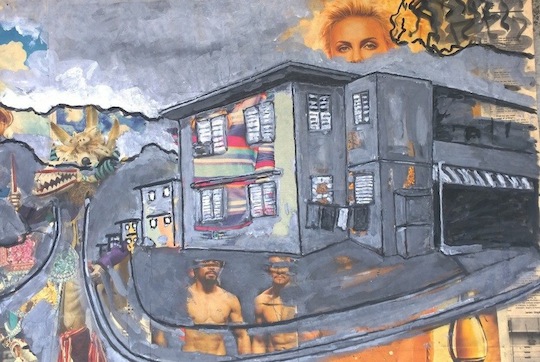
Now available, the catalog for the upcoming exhibition, “Concreto: Pintado En Periodico”, a solo show José Luis Cortés’ work at Museo Casa Escute. The publication includes color reproductions of work in the exhibition, information about the artist, and writing about Cortes’ work. With permission, Visual AIDS provides a sneak peak of the catalog below by excerpting an essay by writer, scholar and performer Larry La Fountain-Stokes. Click here to view the catalog online for free.
Concrete painted on newspaper: about José Luis Cortés
By: Larry La Fountain-Stokes
Life. Presence. Memory.
Everything vanishes.
But before the dust, or perhaps after it, there is life.
Or perhaps the straight lines of plans, scale models, our houses, and news print columns, entangled with bars and power lines, in an imaginary map of the city that poses its eye and records, rescuing spatial and architectural memories.
Our daily bread.
The cup of coffee.
The cigarette and the plants.
The little house.
The duplicity: here and there. In English and Spanish.
The dream of permanence, of modernity. The crow of a rooster. Abandonment. The magic trick that changed it all, that turned countryside into city and jíbaros (peasants) into modern citizens. The little house that could withstand the hurricane. Not gone with the wind.
I grew up in a wood house in Miramar, delivering newspapers that no longer exist, like El Reportero, or that have changed several times, like the San Juan Star. My father came to Puerto Rico from the United States to build private housing developments and then met my mother. I grew up accompanying my father to what would become Plaza Carolina. I left Puerto Rico and met José Luis Cortés in a party in New York City, half naked, painting his face and body with black and white paint while he looked at himself in a tiny mirror and the music deafened us.
José Luis Cortés also grew up between places: Philadelphia, Carolina, San Juan. He moved to New York and fell in love with a newspaper (the New York Times), with our daily paper, buildings, men, and night. But then he came back, with his newspapers, brushes, paints, mental maps and memories.
The uncertainty of life. Its fragility. Like yesterday’s newspaper (el periódico de ayer).
What happens if we take a piece of newspaper and paint a landscape on it in black and white? Why deny the permanence of canvas and the multiplicity of color? And why monumentalize the architecture of modern simplicity and economy, of square houses made out of hot materials, of perhaps anonymous housing projects?
José Luis Cortés’s work appears as a paradox that surprises and requires reflection. In a certain sense, it is radically honest, elaborated with the most primary and accessible materials: the paper that documents it all, that used to accompany us daily and that continues to accompany us in spite of the profound technological transformations. The colors of most basic printing and the first televisions, mixed with the new rainbow of more colorful publications that bleeds into or jumps out in the images. The concrete houses and buildings that, after sixty years of commonwealth modernity, impose themselves, coexist and overtake both the little wood houses and the ancient stately mansions as well as colonial architecture. The visual superimposition of what is behind or can be seen and what comes on top. The newspaper as a palimpsest that holds multiple versions and that is enriched with paint at the same time as it shares its ruin and decomposition. The art of the mundane, of that which accompanies us. The portrait of what we see (or saw when we were small), the shocking image of realism, for example when a factory or sugar mill chimney appears in a landscape by Francisco Oller.
When he lived in New York City, José Luis Cortés monumentalized porn theaters and burlesque houses that were disappearing from Times Square. Now, in his portraits of houses and buildings painted on newspapers in black and white and in his photos of the city, the artist memorializes his childhood town, Carolina, but more than that, he transforms our vision about a moment in the history of Puerto Rico. He rejects dominant abstraction and embraces concrete realism. Of lime, sand and cement. Of wood pulp, paper. Of gouache and acrylic. Of painted houses and painted bodies, graffiti that transforms abandoned buildings, brush strokes that turn his body into a work of art. An ephemeral art that vanishes, but which we take advantage of and see very well today, here. Of art that will be something else tomorrow. With one eye here and another elsewhere.
Lawrence La Fountain-Stokes (also known as Larry La Fountain) is a scholar, writer, and performer. He was born in San Juan, Puerto Rico, in 1968 and now teaches at the University of Michigan, Ann Arbor.
Lawrence La Fountain-Stokes (también conocido como Larry La Fountain) es un escritor, académico y performancero. Nació en San Juan de Puerto Rico en 1968 y ahora enseña en la Universidad de Michigan, Ann Arbor.







Comments
Comments